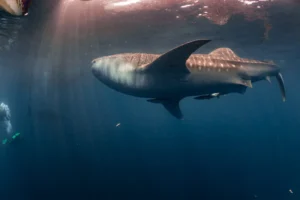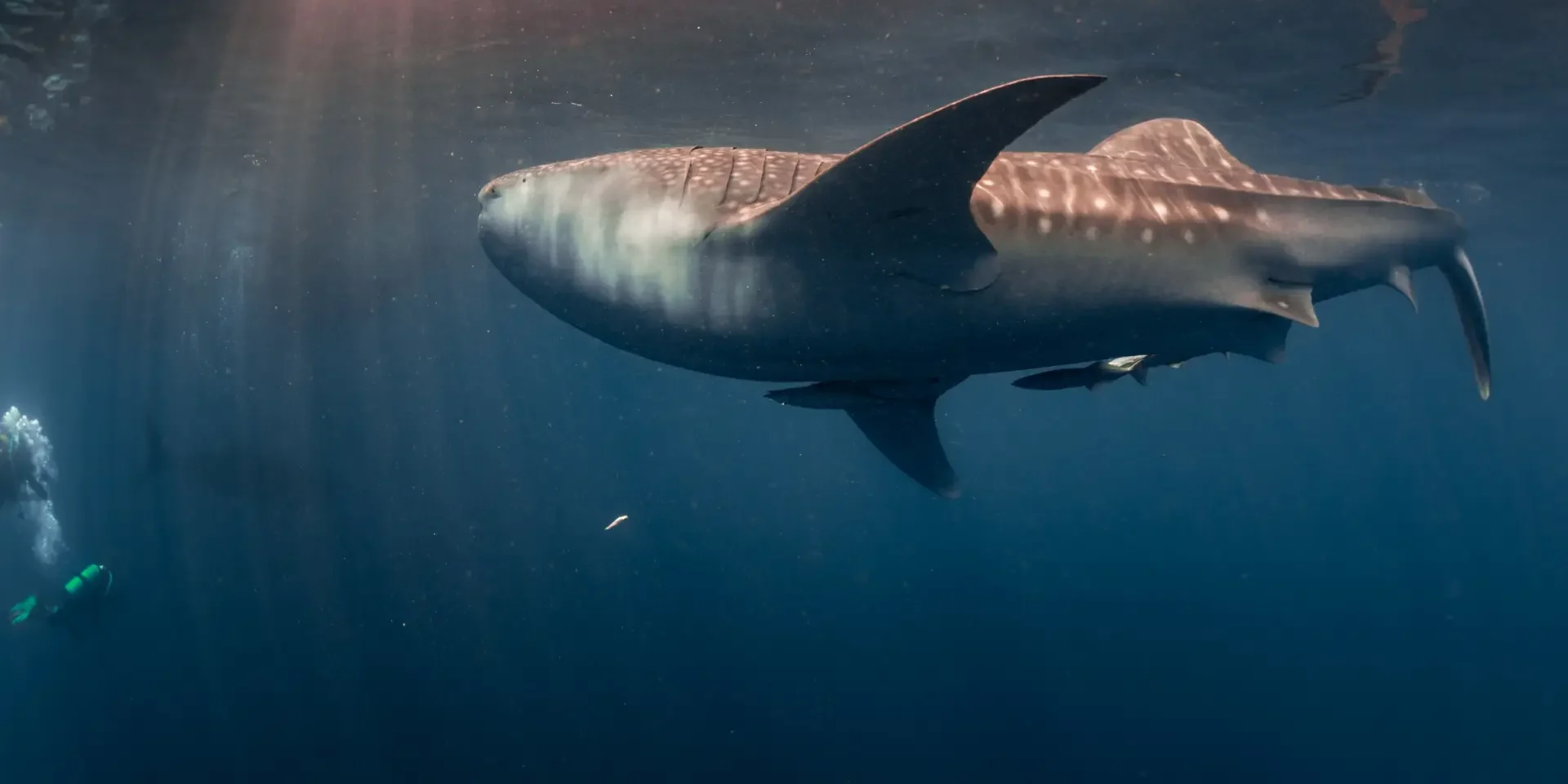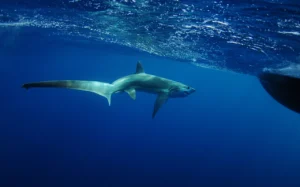Beyond the Reef: A Guide to Shark Encounters in Hurghada
The word “shark” conjures powerful images: sleek, mysterious, and undeniably awe-inspiring. For divers, the chance to share the water with these ancient predators is one of the most sought-after experiences in the underwater world. The Red Sea, with its vibrant ecosystems and deep, nutrient-rich waters, is a historic home to a variety of shark species.
While Hurghada is world-renowned for its stunning coral gardens and kaleidoscopic reef fish, it also serves as a gateway to deeper waters where these incredible encounters are possible. It’s important to set the right expectations; seeing a shark on a typical day trip is a special privilege, not a daily guarantee. However, understanding who you might meet in the blue adds a thrilling layer of anticipation to every dive.
At Scubadore Hurghada, we believe in responsible and respectful marine encounters. A glimpse of a shark is a sign of a healthy ecosystem, and it’s a moment we treat with the reverence it deserves. This guide will introduce you to the remarkable sharks that grace the waters of the Red Sea near Hurghada.
 The Gentle Giant: The Whale Shark (Rhincodon typus)
The Gentle Giant: The Whale Shark (Rhincodon typus)
Let’s start with the largest fish in the sea, a creature that inspires pure wonder rather than fear. The Whale Shark is a slow-moving, filter-feeding giant, and spotting one is a life-changing event for any diver.
- What to Look For: An enormous, broad-headed shark with a distinctive checkerboard pattern of white spots and stripes on its dark grey back. They can grow to over 12 meters (40 feet) long.
- Where and When: These magnificent creatures are a rare sighting in Hurghada, but are more likely to be seen in Hurghada during the warmer months, typically from late May through August, when plankton blooms are at their peak. They are usually found near the surface, gracefully cruising the open water.
- The Encounter: Encounters are almost always a surprise—a huge, spotted shadow gliding past the boat or over the reef. Responsible operators like Scubadore Hurghada will follow strict guidelines: no touching, no chasing, and keeping a respectful distance to allow this gentle giant to go about its business undisturbed.
 The Elegant Hunter: The Thresher Shark (Alopias pelagicus)
The Elegant Hunter: The Thresher Shark (Alopias pelagicus)
Easily one of the most unique and beautiful sharks, the Thresher is another rare but prize sighting for any dedicated diver. They are notoriously shy, making an encounter all the more special.
- What to Look For: Their most famous feature is an extraordinarily long, whip-like upper tail fin, which can be as long as their entire body. They have large eyes and a slender, torpedo-shaped body.
- Where and When: Threshers are deep-water sharks. Encounters in the Hurghada region are rare and typically occur at offshore reefs with deep drop-offs, like the legendary Brothers Islands (accessible via liveaboard). The best chances are often in the cooler months, from September through February, usually at dawn.
- The Encounter: A Thresher sighting is often a fleeting glimpse of its iconic tail disappearing into the deep blue. They are easily spooked, so a calm, quiet approach is essential.
The Sandy Dweller: The Leopard Shark (Stegostoma fasciatum)
Often a source of confusion, this is the shark that divers in the Indo-Pacific call a Leopard Shark, but which is born with stripes, earning it the alternative name, Zebra Shark. They are a common and welcome sight on the sandy bottoms of the Red Sea.
- What to Look For: A stunningly beautiful shark with a cylindrical body, prominent ridges running down its back, and a very long tail fin. Adults have a yellowish body covered in dark leopard-like spots.
- Where and When: Leopard Sharks are bottom-dwellers, often found resting motionless on sandy patches or in gullies near the reef. They are present year-round and are most active at night. During the day, they are usually found “sleeping,” allowing for fantastic photo opportunities.
- The Encounter: These sharks are incredibly docile. As they are often stationary, divers can get a wonderful, prolonged look. It’s crucial not to disturb them by getting too close or using powerful strobes directly in their eyes.
The Classic Predator: The Grey Reef Shark (Carcharhinus amblyrhynchos)
When you picture a “classic” shark patrolling a reef edge, you’re likely picturing a Grey Reef Shark. They are the epitome of streamlined grace and power.
- What to Look For: A stocky, grey-bodied shark with a broadly rounded snout and a distinctive black margin along the entire trailing edge of its tail fin. They typically grow to about 1.9 meters (6 feet).
- Where and When: These sharks are strongly associated with reef environments, particularly the outer drop-offs with strong currents. While not common on Hurghada’s local dive sites, they are more frequently seen at offshore reefs. They are present year-round but can be more active and inquisitive in groups during mating seasons.
- The Encounter: Grey Reef Sharks are curious but cautious. They may circle divers from a distance, observing them. Maintaining a calm demeanor and staying in a group is key. They are a vital part of the reef’s health and a thrilling sight for any diver.
A Note on Other Possibilities & Managing Expectations
The Red Sea is a vast, wild place. While the species above are the most likely sharks you might encounter on trips from Hurghada, others are known to inhabit the wider region, though sightings are exceptionally rare on daily dive trips. These include the powerful Oceanic Whitetip Shark (more common at remote offshore sites like Elphinstone), and even rarer visitors like Hammerheads.
It is crucial to remember that Hurghada’s primary draw is its phenomenal reef health, vibrant coral, and immense fish biodiversity. A shark encounter should be seen as the incredible, unpredictable bonus that it is—a testament to the wildness that still thrives just beyond the reef’s edge.
Diving with Respect and Responsibility
The presence of sharks is the ultimate indicator of a healthy marine ecosystem. As divers, we are privileged guests in their world. At Scubadore Hurghada, our briefings always include guidance on how to behave during a potential shark encounter:
- Stay Calm: Do not make sudden, frantic movements.
- Stay in a Group: Maintain your position with your dive buddy and guide.
- Do Not Chase: Never pursue a shark. Let it come to you or pass by on its own terms.
- Respect Their Space: Do not corner or block the shark’s path.
By choosing an operator that prioritizes marine conservation and education, you contribute to the protection of these magnificent animals for generations to come.
The thrill of diving in Hurghada is in the endless possibility. On any given dive, as you look out from the reef into the deep, endless blue, you never know who might just be swimming by.


 The Elegant Hunter: The Thresher Shark (Alopias pelagicus)
The Elegant Hunter: The Thresher Shark (Alopias pelagicus)




